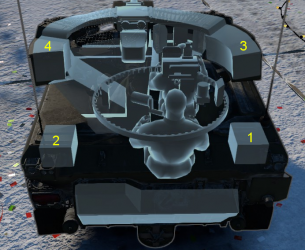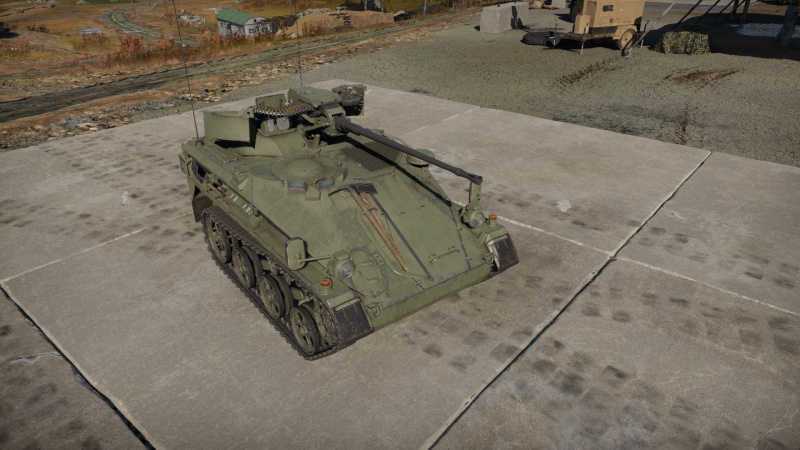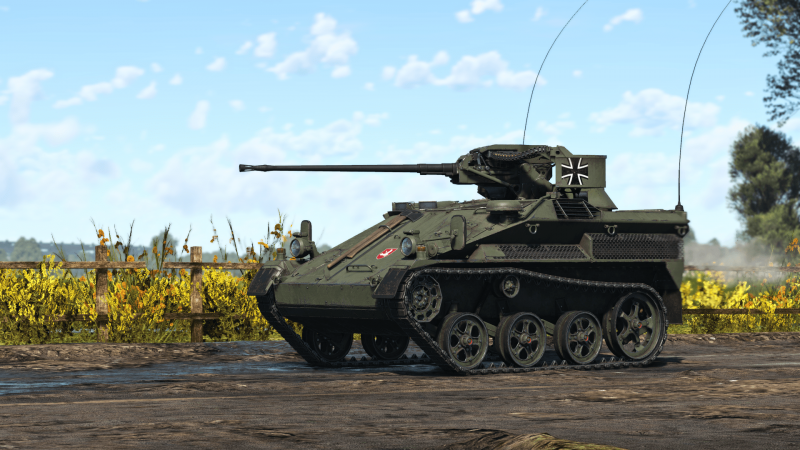Wiesel 1A4
| This page is about the German SPAA Wiesel 1A4. For other versions, see Wiesel (Family). |
Contents
Description
The Waffenträger Wiesel 1A4 MK is a rank German SPAA with a battle rating of (AB), (RB), and (SB). It was introduced in Update "Ground Breaking".
The Wiesel 1A4, while very weak in both armour and armament, is very small and fast compared to most other vehicles at its BR. Given the ability to spot, use thermals, and help teammates with repairs, the Wiesel handles a lot closer to a light tank than an SPAA as it has very limited gun elevation at 45°. Even with its poor elevation, the Rh202 is capable of taking down aircraft found at its BR such as the Su-9 as well as lightly-armoured vehicles like the U-SH 405.
General info
Survivability and armour
The armour is very thin throughout the vehicle, only able to protect from shrapnel and rifle-calibre machine gun fire. Anything with a calibre of 12.7 mm or larger will penetrate. The external fuel tank provides a minor increase in protection, but is still able to be penetrated by large-calibre machine guns. The interior armour provides minor protection to spalling and small shells, but isn't guaranteed to stop anything above 12.7 mm upon penetration. Two vents can be found on the tank with 5 mm of armour, one on the top above the radiator and the other in the middle of the left side, while not much of a difference, if shot at the right angle rifle-calibre machine gun fire can penetrate. The driver and gunner are sitting in a line if looking directly from the front or at a slight angle, which increases the likelihood of getting both knocked out with a single shot. Moreover, as there are only 2 crew members, losing even 1 man will knock out the vehicle unless on a point with crew replenishment.
Armour type:
- Rolled homogeneous armour (Front, side, rear, roof, turret)
| Armour | Front (Slope angle) | Sides | Rear | Roof |
|---|---|---|---|---|
| Hull | 8 mm (61°) Upper glacis 8 mm (10°) Lower plate 8 mm (67°) Lower glacis |
8 mm (33°) Top 8 mm Bottom 8 mm (34°) Lower glacis |
8 mm (47°) Upper plate 8 mm (29°) Lower plate 8 mm (29°-55°) Fuel Tank |
8 mm (29°) Front glacis 8 mm (29°) Driver compartment 6 mm Fighting compartment 5 mm Engine vents |
| Turret | 8 mm (51°) Turret front 6 mm (6°) Optic 6 mm (3°-7°) Ammo |
8 mm (21-40°) Turret | 8 mm (27°) | 6 mm |
Notes:
- There is a 5 mm RHA internal plate separating the engine compartment from the crew.
- Tracks, suspension wheels, and torsion bars are 20 mm thick.
- Mudguards and storage boxes are 5 mm thick, mud flaps are 2 mm thick.
- The gun breech is 150 mm thick and the gun mount is 6 mm thick (including ammo boxes).
Mobility
| Game Mode | Max Speed (km/h) | Weight (tons) | Engine power (horsepower) | Power-to-weight ratio (hp/ton) | |||
|---|---|---|---|---|---|---|---|
| Forward | Reverse | Stock | Upgraded | Stock | Upgraded | ||
| Arcade | Expression error: Unexpected * operator. | 124 | Expression error: Unexpected round operator. | __.__ | |||
| Realistic | 77 | Expression error: Unexpected round operator. | __.__ | ||||
Modifications and economy
Armaments
Main armament
| 20 mm Rh202 | Turret rotation speed (°/s) | Reloading rate (seconds) | ||||||||||||
|---|---|---|---|---|---|---|---|---|---|---|---|---|---|---|
| Mode | Capacity (Belt) | Fire rate | Vertical | Horizontal | Stabilizer | Stock | Upgraded | Full | Expert | Aced | Stock | Full | Expert | Aced |
| Arcade | 400 (100) | 800 | -10°/+45° | ±110° | N/A | 52.8 | 73.1 | 88.8 | 98.2 | 104.5 | 10.40 | 9.20 | 8.48 | 8.00 |
| Realistic | 35.7 | 42.0 | 51.0 | 56.4 | 60.0 | |||||||||
Ammunition
- Default: HVAP-T · HEFI-T
- DM51A1: HEFI-T · HEFI-T · HEFI-T · HVAP-T
- DM43: HVAP-T · HVAP-T · HVAP-T · HEFI-T
- DM63: APDS · APDS · APDS · HEFI-T
| Penetration statistics | |||||||
|---|---|---|---|---|---|---|---|
| Ammunition | Penetration @ 0° Angle of Attack (mm) | ||||||
| 10 m | 100 m | 500 m | 1,000 m | 1,500 m | 2,000 m | ||
| HVAP-T | 57 | 52 | 37 | 24 | 15 | 10 | |
| HEFI-T | 7 | 6 | 5 | 3 | 2 | 2 | |
| APDS | 66 | 61 | 45 | 31 | 21 | 14 | |
| Shell details | ||||||||||||
|---|---|---|---|---|---|---|---|---|---|---|---|---|
| Ammunition | Velocity (m/s) |
Projectile mass (kg) |
Fuse delay (m) |
Fuse sensitivity (mm) |
Explosive mass (TNT equivalent) (g) |
Ricochet | ||||||
| 0% | 50% | 100% | ||||||||||
| HVAP-T | 1,100 | 0.11 | - | - | - | 66° | 70° | 72° | ||||
| HEFI-T | 1,100 | 0.13 | 0.1 | 0.1 | 11.05 | 79° | 80° | 81° | ||||
| APDS | 1,150 | 0.13 | - | - | - | 75° | 78° | 80° | ||||
Ammo racks

| Full ammo |
Ammo type |
1st rack empty |
2nd rack empty |
3rd rack empty |
4th rack empty |
Visual discrepancy |
|---|---|---|---|---|---|---|
| 4 400 |
Magazines Rounds |
3 (+1) 300 (+100) |
2 (+2) 200 (+200) |
1 (+3) 100 (+300) |
0 (+4) 0 (+400) |
No |
Notes:
- The ammunition is modeled as 4 magazines of 100 rounds.
- Even though racks 3 & 4 both are fed into the gun, the gun still reloads when switching from rack 3 to 4.
Usage in battles
The Wiesel 1A4 is small, light and thus has great acceleration, which can help you to get to positions early and to arrive at capture points before the enemies. Given its very low profile, it can hide behind almost everything and can provide support for the team. The Wiesel 1A4 is very lightly armoured, thus it should not be used to attack enemies head-on but instead act as an intelligence vehicle for the team, scouting and marking enemies on the minimap for your teammates. The Rh202 20 mm is effective against lightly armored vehicles, but it has low post-penetration damage, meaning you may need to aim for specific components to do significant damage. It is very effective if used as a spotter because it has Generation 3 thermals, something essentially no other vehicle at its BR can boast, and with its low profile and high mobility it gets around the map extremely effectively. As for anti-aircraft purposes, its limited elevation of 45 degrees can hinder its performance, but the gun makes quick work of any low flying aircraft that fly within your elevation range. With this much scouting, the Wiesel 1A4 can also work as an effective segway into an aircraft, as you can scout enemies constantly while hiding in unorthodox spots and lead your teammates to the unsuspecting enemies in front of you. It is especially effective in uptiers, as you may feel that your other vehicles may not handle opponents of a higher BR bracket, and thus want to support the team via aircraft or helicopters instead.
Another useful ability is the fact that the Wiesel 1A4 is equipped with a Laser Rangefinder (LRF). This allows the Wiesel to precisely determine the range to a target and automatically elevate its gun barrel, letting your shots connect with very little margin for error. This has two main uses - the first, to hit light targets such as enemy SPAAs (ZSU-23-4s, ZSU-37-2s, ZSU-57-2s and M163s among many others) or IFVs (M3, BMP-1s and BMP-2s) with pinpoint accuracy at range, to reduce the chance of enemy return fire. The second is in a squad, where you may team up with vehicles such as the Centurion Mk.5 AVRE to gauge the precise distance to a target using your LRF, allowing your squadmate to lob a shell with lethal accuracy with your help. This, however, may require some pre-planning between the two users before the match and will only come into play with careful coordination.
In conclusion, the Wiesel 1A4 has a rather passive playstyle, with very limited anti-tank options. You can rush a capture point early on with your mobility, find a well-protected hiding spot and scout enemy targets for your team before getting into an aircraft after dying, or try and support your teammates more directly by flanking aggressively with the APDS belt to shred enemy IFVs and light tanks, disable the barrels, tracks and engines of heavier armor and shoot down the occasional aircraft or helicopter (the latter of which can be LRFed for better precision). In premade squads it can also be an effective battle coordinator for the squad with its good thermal vision sights, small size, scouting and laser rangefinder.
Pros and cons
Pros:
- Excellent acceleration and mobility
- Good anti-air capability
- Low profile, can hide in small areas
- High rate of fire on the Rh202 20mm
- Access to 3rd generation thermals, the DM63 APDS belt and a laser rangefinder
- Can scout enemy targets
- Effective firepower against lighter enemy targets
- High utility
Cons:
- Paper-thin armour
- Lacks consistent anti-tank abilities against contemporary enemies
- Low post-penetration damage
- Non-360° turret
- Gun overheats relatively quickly
- Poor gun elevation compared to other SPAAs
History
Development
Initially developed in 1979 by Rheinmetall for the Bundeswehr as an airborne light armoured vehicle, the Wiesel was equipped with Rheinmetall's own Mk 20 RH-202 20 mm autocannon and designed to be small enough to fit inside standard NATO transport aircraft and even the CH53G Sea Stallion helicopter. The Wiesel was supposedly capable of being air dropped alongside airborne elements and was meant to act as armoured support for airborne troops though this idea was abandoned due to many failed tests. The Wiesel 1A4 was designed to combat infantry, tanks, armoured vehicles, and even aircraft. The Wiesel program was temporarily shut down in 1978 due to a lack of adequate funding though continued development later after interest was heard from other countries. The Bundeswehr eventually ordered 343 Wiesels in 1985.
Combat usage
The Wiesel 1A4 first saw service in 1993 as a part of the UN mission to Somalia (UNOSOM II) as part of the German peacekeeping force. Soon after, the Wiesel participated in NATO's Implementation Force (IFOR) which took place in Bosnia and Herzegovina from 1995-1996. Continuing after was NATO's Stabilization Force (SFOR) also taking place in Bosnia and Herzegovina from 1996-2004. It participated in yet another NATO mission in Kosovo as part of the Kosovo Force (KFOR) from 1999-Present (2022). The Wiesel then was a part of Operation Essential Harvest taking place in the Republic of Macedonia in 2001 to combat insurgencies. Lastly, Wiesel took part in the International Security Assistance Force (ISAF) in Afghanistan from 2001-2014.
Media
- Skins
- Videos
See also
External links
| Germany anti-aircraft vehicles | |
|---|---|
| Wheeled | Sd.Kfz.222 |
| Half-track | Sd.Kfz.251/21 · Sd.Kfz. 6/2 |
| Flakpanzer IV | Wirbelwind · Ostwind · Ostwind II · Kugelblitz · Zerstörer 45 |
| Other Flakpanzers | Flakpanzer I · Flakpanzer 38 · Flakpanzer 341 |
| Wiesel AWC | Wiesel 1A4 · Ozelot |
| Radar SPAAG | Gepard · Gepard 1A2 |
| Missile SPAA | FlaRakPz 1 · FlaRakRad |






